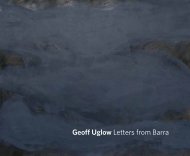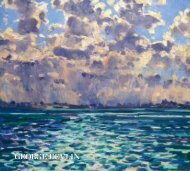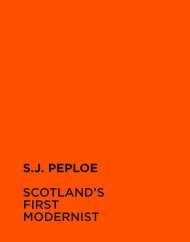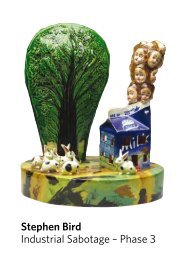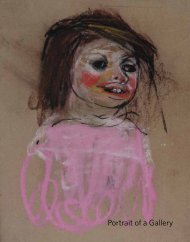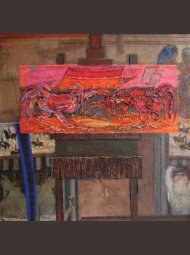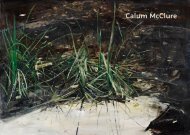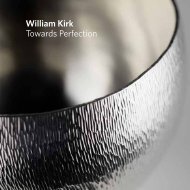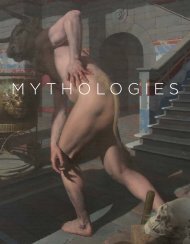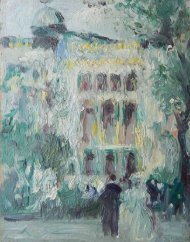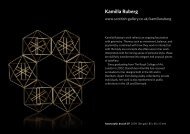Download a PDF of the exhibition catalogue - The Scottish Gallery
Download a PDF of the exhibition catalogue - The Scottish Gallery
Download a PDF of the exhibition catalogue - The Scottish Gallery
You also want an ePaper? Increase the reach of your titles
YUMPU automatically turns print PDFs into web optimized ePapers that Google loves.
Townhead<br />
“Traditionally, painting students went <strong>the</strong>re<br />
for inspiration and subject matter – mainly for<br />
romantic reasons, because <strong>the</strong> flat landscape and<br />
its still, gleaming water, little wind up bridges<br />
and gas lamps felt unlike Glasgow. What Eardley<br />
discovered, however, and soon began to explore<br />
with typical singlemindedness in graphic terms,<br />
was not <strong>the</strong> romantic, atmospheric canal-scape,<br />
as such. It was that fringe <strong>of</strong> gaunt tenements and<br />
back-courts, <strong>the</strong> dark strength <strong>of</strong> <strong>the</strong>ir forms and<br />
<strong>the</strong> unexpected colour in <strong>the</strong>ir peeling masonry,<br />
<strong>the</strong> sense <strong>of</strong> movement and <strong>the</strong> liveliness in <strong>the</strong>ir<br />
surfaces as <strong>the</strong> window-glass darkly sucked in, or<br />
gleamingly rebuffed <strong>the</strong> daylight. Before long <strong>the</strong><br />
inner life implicit in <strong>the</strong> lines <strong>of</strong> coloured washing<br />
appeared in <strong>the</strong> flesh. Insouciant, tattered<br />
urchins presented <strong>the</strong>mselves, chattering, and<br />
<strong>the</strong> timid ones soon followed, for Joan Eardley<br />
attracted children like insects to a honeypot.”<br />
Cordelia Oliver, Joan Eardley and Glasgow,<br />
<strong>Scottish</strong> Art Review, Special Number. Vol XIV<br />
no. 3, 1974, p17<br />
Townhead (Scots: Toun-heid) was an area <strong>of</strong><br />
Glasgow which lay close to George Square and<br />
<strong>the</strong> City Chambers going towards Glasgow<br />
Ca<strong>the</strong>dral and <strong>the</strong> High Street. Being so close<br />
to <strong>the</strong> city centre, <strong>the</strong> slums were hard to<br />
avoid. In <strong>the</strong> 1960’s, Townhead was designated<br />
a Comprehensive Development Area (CDA),<br />
which meant that it would be largely demolished<br />
to make way for modern tower blocks and a<br />
controversial inner city road system. Today, a<br />
few surviving tenements are all that remain <strong>of</strong><br />
Townhead.<br />
Joan Eardley took her first studio in Cochrane<br />
Street near <strong>the</strong> City Chambers in 1949, moving<br />
later to an old photographer’s studio at 204<br />
St James’s Road in Townhead in 1952. Local<br />
industry included a concentration <strong>of</strong> printing<br />
works and <strong>the</strong> Sun Foundry on Kennedy Street.<br />
<strong>The</strong> population <strong>of</strong> Townhead was at its peak<br />
in 1951 (117 per acre). By <strong>the</strong> mid 1960’s, <strong>the</strong><br />
majority <strong>of</strong> <strong>the</strong> buildings and people <strong>of</strong> Townhead<br />
were gone. Eardley’s powerful drawings and<br />
paintings <strong>of</strong> urban dereliction in Glasgow<br />
during this period are poignant depictions <strong>of</strong><br />
<strong>the</strong> character <strong>of</strong> <strong>the</strong> place, indivisible from <strong>the</strong><br />
character <strong>of</strong> its people. Her studio was top lit<br />
and kept warm with a large stove; <strong>the</strong> interior<br />
and structure <strong>of</strong> <strong>the</strong> building was held up with<br />
scaffolding. She kept a camera in her studio to<br />
capture <strong>the</strong> surrounding street life, and her fast<br />
moving child subjects; <strong>the</strong>se photographs were<br />
used as reference points for sketches and finished<br />
paintings.<br />
“What is particularly striking about <strong>the</strong>se<br />
photographs, <strong>the</strong> studies and <strong>the</strong> final works is<br />
<strong>the</strong> sense <strong>of</strong> <strong>the</strong> protective, adult awareness <strong>of</strong><br />
<strong>the</strong> children. <strong>The</strong> expressive faces and <strong>the</strong> direct<br />
stares <strong>of</strong> <strong>the</strong> children are remarkable in <strong>the</strong><br />
history <strong>of</strong> British art. <strong>The</strong>re is no social message,<br />
no emotive thrust… <strong>The</strong> children are symbolic<br />
<strong>of</strong> a worldly streetwise mode <strong>of</strong> living… She saw<br />
<strong>the</strong> ruin and decay <strong>of</strong> objects as a witness to <strong>the</strong><br />
passage <strong>of</strong> life.”<br />
Joan Eardley 1921-1963, <strong>Scottish</strong> Masters 6<br />
by Fiona Pearson, 1988, <strong>The</strong> Trustees <strong>of</strong> <strong>the</strong><br />
National Galleries <strong>of</strong> Scotland<br />
Joan in her Townhead studio. Pink Jumper<br />
(p54) can be seen top right. Photograph by<br />
Audrey Walker<br />
36



